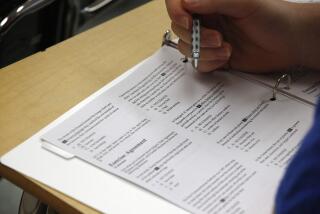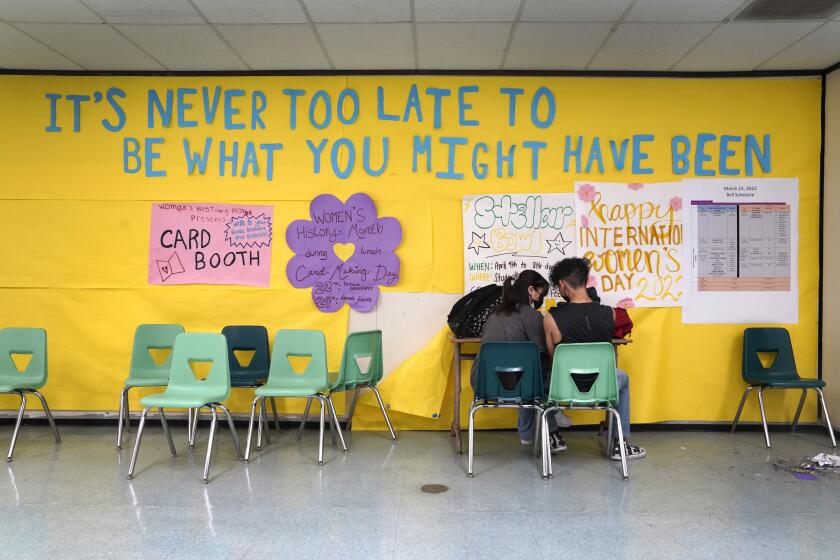California accelerates shift in student testing
In a major shift in how California’s 6.2 million public school students are taught and tested, state officials plan to drop the standardized exams used since 1999 and replace them with a computerized system next spring.
The move would advance new learning goals, called the Common Core, which are less focused on memorizing facts. They are designed instead to develop critical thinking and writing skills that take formerly separate subjects — such as English and history or writing and chemistry — and link them. Forty-five states have adopted these standards.
California is moving up its timetable for the new computerized tests by a year, leaving some school districts scrambling to prepare.
Schools must have enough computers available on each campus to handle the testing, for example. Until now, state standardized tests were conducted entirely with pencil and paper.
The new exams also would upend plans in the Los Angeles Unified School District to use student test scores to evaluate teachers. Such performance reviews would be impossible because the results could not be compared to previous years.
The plan emerged in written form Wednesday afternoon, after intense negotiations that included the governor’s office, state Supt. of Public Instruction Tom Torlakson, legislative leaders and the state’s powerful teacher unions.
The legislation “shows California’s commitment to implementing Common Core standards and helping every student succeed,” said Evan Westrup, a spokesman for Gov. Jerry Brown. “The governor strongly supports this legislation.”
The state hopes the cost will be covered by money saved from suspending the old tests, for which California budgeted about $64 million.
Still to weigh in is the Education Department of the Obama administration, which is expected to scrutinize the proposal because elements violate current federal law. Specifically, scores for students and schools will not be released, making it more difficult to assess whether schools are improving.
The test is not yet ready for that purpose, officials said.
“These tests next year are not about scores,” said Deputy Supt. Deborah Sigman. “This is about testing the test and giving students and teachers experience about what this test will look like.”
Certain questions, for example, might prove to have biased results depending on a student’s gender or could have ambiguous wording. A new feature of the computer-based test is that it will get more difficult or easier depending on student answers.
Districts won’t even receive the results, which bothers some advocates. Moreover, there will only be a limited menu of exams. The new tests, in math and English, would be given in grades three through eight and 11th grade. The old tests would still be used, for now, to measure science in three grades.
Teachers and school systems need the breathing room to make the transition, said state Assemblywoman Susan Bonilla (D-Concord), author of the legislation.
“As a former teacher I feel this will really help the morale of teachers,” Bonilla said. The message is: “We’re going to make your job a little easier by letting you focus on what we say is the priority.”
In the process, the state would drop tests in social studies and end-of-year subject exams for older students, such as the test in algebra. The state plans to tackle how to assess such subjects at a later time.
“I’m troubled by the notion that you wouldn’t provide parents with information on their children’s performance, or educators with information on their students’ performance for an entire year,” said Arun Ramanathan, executive director of Education Trust-West, an Oakland-based advocacy group.
He thinks the results of the new test could be shared. Another option would be to keep the old tests in place and use the new tests on a limited basis, simply to determine what adjustments are necessary.
That was the original plan: 20% of California students in all were to take either the new math or English test. But some school systems, including L.A. Unified, objected.
L.A. schools Supt. John Deasy didn’t want instructors teaching to the old test while also having to prepare for something new. For weeks, he’s pushed behind the scenes for permission to move the nation’s second-largest school system entirely to the new test and students would take the new exam on iPads that he intends to provide to each of them.
The state’s new approach is sound, provided that California pays for all students in a district to take the new tests in English and math, Deasy said.
“The smart thing and the right thing is to make sure students and teachers have experience with the assessment before it counts,” Deasy said.
But the proposal also means that another hard-fought initiative is potentially derailed for at least two years. Deasy had pushed relentlessly to make student standardized test scores a significant factor in teacher evaluations.
That would not be possible next year and the following year might only be useful to establish a baseline for future years. The district also has talked of needing three years of data for a full picture of a teacher’s effectiveness.
“It will leave me with a potentially incomplete evaluation,” Deasy said.
But Deasy added that teacher evaluation will not go on hiatus in any scenario. Principals will observe teachers, for example, and a wide range of measures can be used to get an accurate picture of a teacher’s performance.
“This doesn’t mean we take our eye off of what happens in schools at all,” Deasy said.
Some school districts may have a problem simply giving the tests because of out-of-date computers or a shortage of those that work at all. Officials acknowledged this would be a challenge to work through.
But the goal, said Torlakson, is “not to look in the rear-view mirror...but to really move ahead.”
howard.blume@latimes.com
More to Read
Start your day right
Sign up for Essential California for news, features and recommendations from the L.A. Times and beyond in your inbox six days a week.
You may occasionally receive promotional content from the Los Angeles Times.






